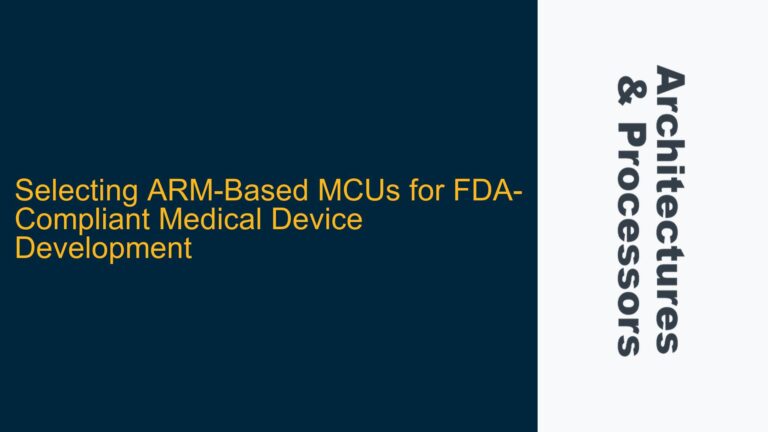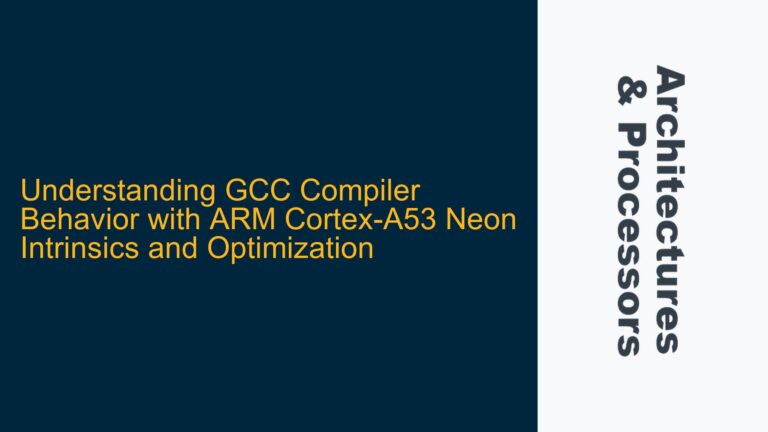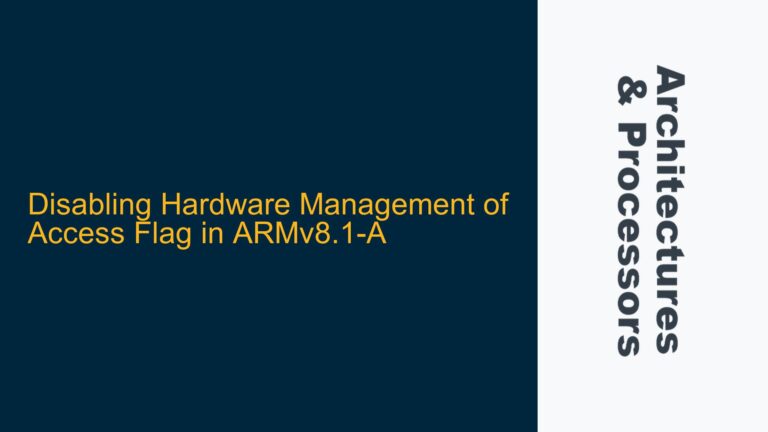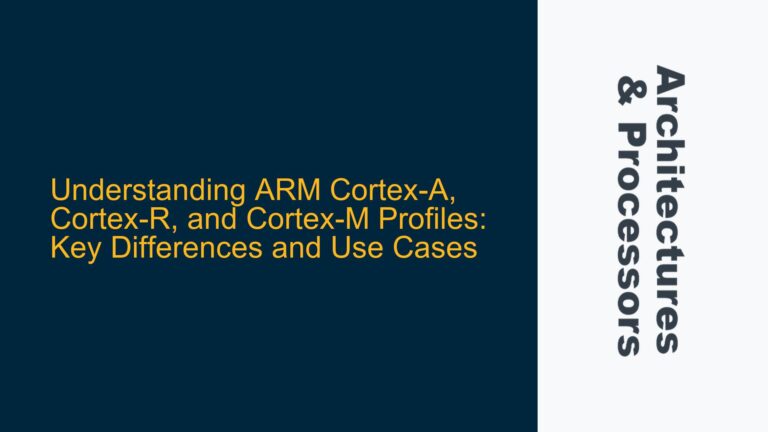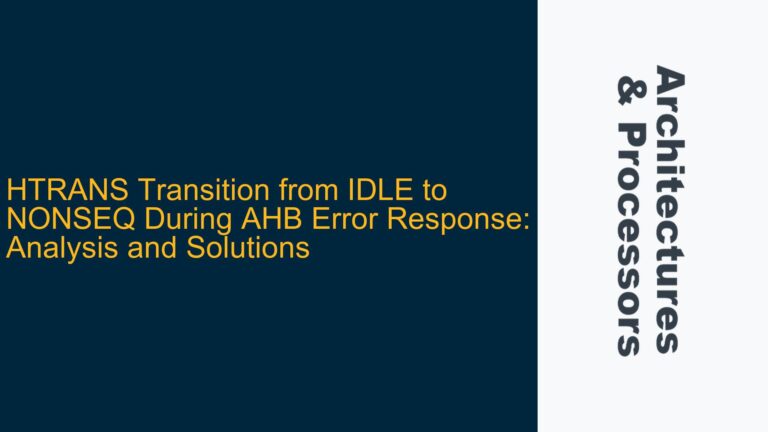ARMv8-A MRS CPSR/APSR Instruction Latency and Its Impact on Real-Time Systems
The MRS (Move to Register from System Register) instruction in ARMv8-A architectures is a critical operation for reading system registers such as the Current Program Status Register (CPSR) or the Application Program Status Register (APSR). Understanding the latency of this instruction is essential for real-time systems where timing predictability is paramount. The latency of the MRS CPSR/APSR instruction can vary depending on the specific ARM core implementation, pipeline depth, and surrounding microarchitectural optimizations. This post delves into the latency characteristics of the MRS instruction, its implications for real-time systems, and strategies to mitigate potential bottlenecks.
ARMv8-A MRS CPSR/APSR Latency: Core Concepts and Timing Dependencies
The MRS instruction is used to transfer the contents of a system register, such as CPSR or APSR, into a general-purpose register. The CPSR and APSR contain critical state information, including condition flags, interrupt masks, and execution mode bits. In real-time systems, reading these registers without introducing unpredictable delays is often necessary to ensure deterministic behavior.
The latency of the MRS instruction is influenced by several factors:
- Pipeline Depth and Staging: ARMv8-A processors typically employ deep pipelines to achieve high clock speeds. The MRS instruction must traverse these pipeline stages, and the number of cycles required depends on the pipeline design.
- System Register Access Timing: Accessing system registers like CPSR or APSR may involve additional cycles due to the need to synchronize with other pipeline stages or to resolve dependencies.
- Microarchitectural Optimizations: Features such as out-of-order execution, speculative execution, and branch prediction can impact the effective latency of the MRS instruction.
For example, in the Cortex-A9 processor, the MRS instruction is documented to take 1 cycle. However, this value is specific to the Cortex-A9 and may not apply to other ARMv8-A cores. The Technical Reference Manual (TRM) for each processor provides cycle-accurate timing information, but these values must be interpreted in the context of the overall system design.
Potential Causes of MRS CPSR/APSR Latency Variability
The latency of the MRS CPSR/APSR instruction can vary due to several architectural and microarchitectural factors. Understanding these causes is crucial for diagnosing and mitigating latency issues in real-time systems.
- Pipeline Stalls and Hazards: The MRS instruction may cause pipeline stalls if it depends on the result of a previous instruction or if it triggers a pipeline flush. For example, if the MRS instruction follows a branch instruction that is mispredicted, the pipeline may need to be flushed, increasing the effective latency.
- System Register Access Contention: In multi-core or multi-threaded systems, contention for system registers can introduce additional latency. For instance, if multiple cores attempt to access the CPSR simultaneously, arbitration logic may delay the access.
- Cache and Memory Subsystem Interactions: Although the CPSR and APSR are not memory-mapped, their access may still be influenced by the state of the cache and memory subsystem. For example, if the processor is servicing a cache miss or a memory access, the MRS instruction may be delayed.
- Power Management and Clock Gating: Modern ARM processors employ dynamic power management techniques such as clock gating and voltage scaling. These techniques can introduce variability in instruction latency, including the MRS instruction.
Mitigating MRS CPSR/APSR Latency: Strategies for Real-Time Systems
To ensure deterministic behavior in real-time systems, developers must carefully manage the latency of the MRS CPSR/APSR instruction. The following strategies can help mitigate latency variability and improve system predictability.
- Referencing Processor-Specific TRMs: The first step in managing MRS latency is to consult the Technical Reference Manual (TRM) for the specific ARM core being used. The TRM provides detailed information on instruction timing, including the number of cycles required for the MRS instruction. For example, the Cortex-A9 TRM specifies that the MRS instruction takes 1 cycle, but this value may differ for other cores.
- Minimizing Pipeline Stalls: To reduce the impact of pipeline stalls, developers should avoid placing the MRS instruction immediately after branches or other instructions that may cause pipeline flushes. Additionally, ensuring that the MRS instruction does not depend on the result of a previous instruction can help minimize stalls.
- Synchronizing System Register Access: In multi-core or multi-threaded systems, developers should implement synchronization mechanisms to prevent contention for system registers. For example, using spinlocks or semaphores to serialize access to the CPSR can help reduce latency variability.
- Optimizing Cache and Memory Subsystem: Although the CPSR and APSR are not memory-mapped, optimizing the cache and memory subsystem can indirectly improve the performance of the MRS instruction. For example, ensuring that the cache is properly warmed up and that memory accesses are minimized can reduce the likelihood of delays.
- Disabling Power Management Features: In real-time systems where timing predictability is critical, developers may consider disabling dynamic power management features such as clock gating and voltage scaling. While this may increase power consumption, it can help ensure consistent instruction latency.
Example: Analyzing MRS Latency in a Cortex-A53 System
To illustrate the concepts discussed above, consider a real-time system based on the ARM Cortex-A53 processor. The Cortex-A53 is a popular choice for embedded systems due to its balance of performance and power efficiency. However, its deep pipeline and out-of-order execution capabilities can introduce variability in instruction latency.
- Consulting the Cortex-A53 TRM: The Cortex-A53 TRM provides detailed timing information for the MRS instruction. According to the TRM, the MRS instruction typically takes 1 cycle to execute. However, this value assumes ideal conditions and does not account for pipeline stalls or other microarchitectural effects.
- Measuring MRS Latency: To validate the TRM’s timing information, developers can use performance counters or cycle-accurate simulators to measure the actual latency of the MRS instruction in their specific system. This measurement can help identify any discrepancies between the documented and observed latency.
- Optimizing Instruction Placement: Based on the measured latency, developers can optimize the placement of the MRS instruction in their code. For example, placing the MRS instruction in a section of code with minimal pipeline hazards can help ensure consistent timing.
- Implementing Synchronization Mechanisms: If the system includes multiple cores or threads, developers should implement synchronization mechanisms to prevent contention for the CPSR. For example, using a spinlock to serialize access to the CPSR can help reduce latency variability.
Conclusion
The latency of the MRS CPSR/APSR instruction in ARMv8-A architectures is a critical consideration for real-time systems. While the MRS instruction is typically documented to take 1 cycle, its effective latency can vary due to pipeline stalls, system register contention, and other microarchitectural factors. By consulting processor-specific TRMs, minimizing pipeline hazards, synchronizing system register access, and optimizing the cache and memory subsystem, developers can mitigate latency variability and ensure deterministic behavior in their systems. In cases where timing predictability is paramount, disabling dynamic power management features may also be necessary. Through careful analysis and optimization, developers can harness the full potential of ARMv8-A processors while meeting the stringent requirements of real-time systems.


